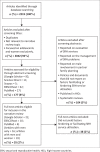Men's utilisation of sexual and reproductive health services in low- and middle-income countries: A narrative review
- PMID: 37435118
- PMCID: PMC10331170
- DOI: 10.4102/sajid.v38i1.473
Men's utilisation of sexual and reproductive health services in low- and middle-income countries: A narrative review
Abstract
Background: Men have poor access to sexual and reproductive health (SRH) services globally, particularly in low- and middle-income countries (LMICs). Nevertheless, in LMIC and high-income countries (HICs), low SRH utilisation happens on account of several factors, such as individual, health system-related, and sociocultural factors. Identifying and addressing men's SRH service underutilisation remains essential to improving their sexual health and averting higher mortality and early morbidity associated with poor health seeking behaviour (HSB) among men.
Aim: This narrative review identifies factors influencing whether men do or do not utilise SRH services in LMICs.
Setting: We report on articles published in LMICs: Africa, Asia and South America.
Method: In this narrative review, we searched for quantitative and qualitative articles published between 2004 and 2021 from international databases, including Google Scholar, ScienceDirect, EBSCOhost, Scopus, PubMed, Medline, and reference lists of retrieved published articles.
Results: A total of 2219 articles were retrieved, from which 36 met the inclusion criteria. Factors contributing to poor uptake of SRH services by men included: a lack of access and availability of SRH services, poor health-seeking behaviour among men, and SRH facilities not being perceived as 'male-friendly spaces'. Furthermore, our review reveals that decreased use of SRH services is attributed to factors such as a lack of focus on men's SRH.
Conclusion: The current underutilised state of SRH services calls for urgent implementation of evidence-based interventions. Identifying men's SRH service inhibitors and enablers will assist programme managers and policymakers in designing SRH services tailored to their sexual health needs.
Contribution: Despite numerous global interventions to motivate men, the findings provide insight into the underutilisation of SRH services. The study also reveals the inadequate comprehensive investigation of men's SRH service utilisation, especially older men, to comprehend men's problems fully. Further research needs to be conducted on SRH issues, including vasectomy, mental health, and chronic conditions related to sexual and reproductive health. The analysis can assist SRH policymakers and program managers in strengthening the policies to motivate men to engage better with SRH services.
Keywords: factors facilitating or inhibiting the SRH service utilisation; factors influencing SRH service utilisation; low- and middle-income countries; men; sexual and reproductive health services.
© 2023. The Authors.
Conflict of interest statement
The authors declare that they have no financial or personal relationships that may have inappropriately influenced them in writing this article.
Figures
Similar articles
-
Using the Nominal Group Technique to Inform Approaches for Enhancing Men's Utilization of Sexual and Reproductive Health Services.Int J Environ Res Public Health. 2024 May 31;21(6):711. doi: 10.3390/ijerph21060711. Int J Environ Res Public Health. 2024. PMID: 38928957 Free PMC article.
-
Exploratory Qualitative Study to Investigate Factors Influencing Men's Utilization of Sexual and Reproductive Health Services in Kwa-Zulu Natal.Int J Environ Res Public Health. 2024 Dec 8;21(12):1632. doi: 10.3390/ijerph21121632. Int J Environ Res Public Health. 2024. PMID: 39767472 Free PMC article.
-
Scoping review of sexual and reproductive healthcare for men in the MENA (Middle East and North Africa) region: a handful of paradoxes?BMC Public Health. 2023 Mar 27;23(1):564. doi: 10.1186/s12889-022-14716-2. BMC Public Health. 2023. PMID: 36973770 Free PMC article.
-
Sexual and reproductive health among forcibly displaced persons in urban environments in low and middle-income countries: scoping review findings.Reprod Health. 2024 Apr 12;21(1):51. doi: 10.1186/s12978-024-01780-7. Reprod Health. 2024. PMID: 38609975 Free PMC article.
-
Factors influencing men's decisions to utilize sexual reproductive health services in KwaZulu Natal, South Africa.Afr J Reprod Health. 2023 Apr;27(4):24-33. doi: 10.29063/ajrh2023/v27i4.3. Afr J Reprod Health. 2023. PMID: 37584905
Cited by
-
Economic evaluations of sexual and reproductive health (SRH) services in low- and middle-income countries (LMICs): a systematic review.BMJ Open. 2025 Mar 17;15(3):e092837. doi: 10.1136/bmjopen-2024-092837. BMJ Open. 2025. PMID: 40097233 Free PMC article.
-
Using the Nominal Group Technique to Inform Approaches for Enhancing Men's Utilization of Sexual and Reproductive Health Services.Int J Environ Res Public Health. 2024 May 31;21(6):711. doi: 10.3390/ijerph21060711. Int J Environ Res Public Health. 2024. PMID: 38928957 Free PMC article.
-
Sexual attitudes and utilization of sexual and reproductive health services among older women in southern China: a qualitative study.Front Public Health. 2024 Mar 21;12:1327734. doi: 10.3389/fpubh.2024.1327734. eCollection 2024. Front Public Health. 2024. PMID: 38577286 Free PMC article.
-
Exploratory Qualitative Study to Investigate Factors Influencing Men's Utilization of Sexual and Reproductive Health Services in Kwa-Zulu Natal.Int J Environ Res Public Health. 2024 Dec 8;21(12):1632. doi: 10.3390/ijerph21121632. Int J Environ Res Public Health. 2024. PMID: 39767472 Free PMC article.
-
Urban‒rural differences and determinants of utilization of sexual and reproductive health services among males in Anambra State, South-eastern Nigeria.BMC Health Serv Res. 2025 Jun 2;25(1):784. doi: 10.1186/s12913-025-12951-y. BMC Health Serv Res. 2025. PMID: 40457399 Free PMC article.
References
-
- Jobson M. Structure of the health system in South Africa. South Africa Khulumani Support Group: Johannesburg; 2015.
-
- De Silva VP. World book of family medicine: Sexual and reproductive health in primary care: Where do we go from here? vol. 26. Wonca Europe: Iberoamericana Edition: Portugal; 2016, p. 1–4.
-
- Department of Health (DOH) . Sexual and reproductive health and rights: Fulfilling our commitments 2011–2021 and beyond [homepage on the Internet]. 2011. [cited 2020 Jun 21]. Available from: http://www.agenda.org.za
Publication types
LinkOut - more resources
Full Text Sources
Miscellaneous


